Diane: We head out for Peru today. We are meeting a new acquaintance, Miguel, at the bus station at 11:00 pm tonight to head down to Chiclayo, Peru together. To me it seems an almost impossible coincidence, but Miguel is from Chiclayo and is heading back the same day we are.
We've lived in Cuenca for about four and a half months, in a city filled with quirks and charms, most of which I have not mentioned here. For example, the traditional clothing of the local women includes delicately sewn blouses, brightly colored, embroidered, flared skirts, and a particular style of hat. You see variations on this style everywhere from the markets to the banks.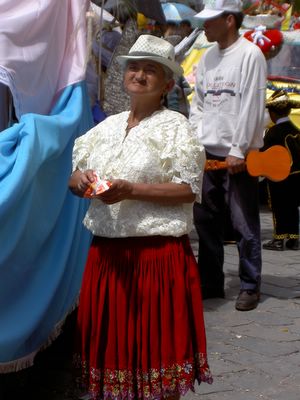
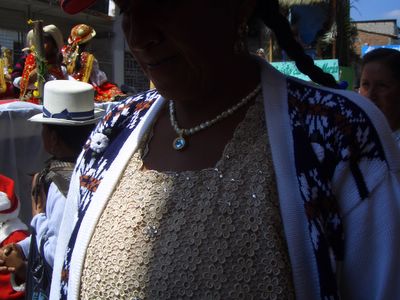
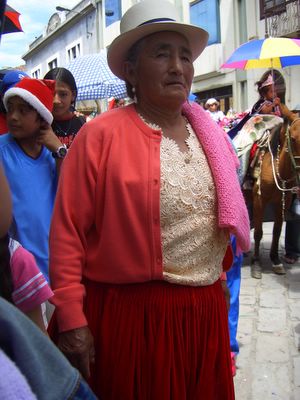
I also love the mix of old and new.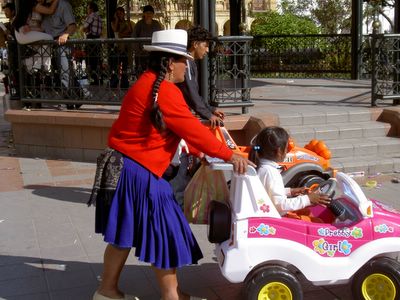
Ice cream and various forms of popsicles are very popular in Cuenca. Although there are national brands of ice cream widely available, many small Mom-and-Pop shops make their own. Some are chunkier; some have more flavor; some are creamy. On our pedestrian commute into the Historic Center each day, we generally take a route that leads over a bridge and up a beautiful stone staircase. Half a block from the top of the stairs is my favorite home-made cocoanut ice cream. Additionally, on a sunny day, there are always mobile "Bon Ice" vendors on the ready. They wear colorful blue and pink uniforms and do tons of business.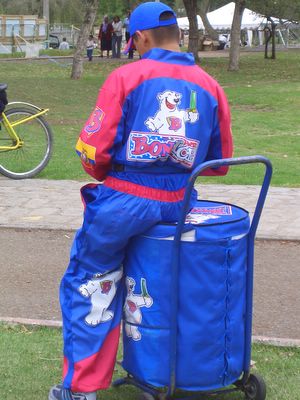
Other street vendors congregate around special events or schools and churches when they let out, selling candy apples, this creamy stuff plopped on top of an ice cream cone (that, thankfully, I managed to avoid), plantain chips, seasonal fruit, and other munchies.
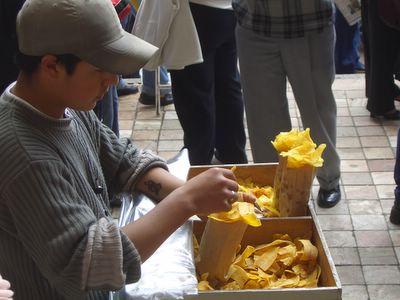
My favorite street vendors sell blow-up beach toys during special events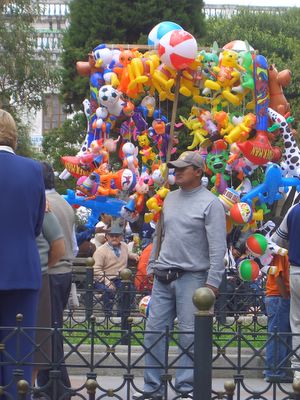
The interior of Cuenca's New Cathedral is in my view the most beautiful of any in Ecuador. Having only seen a handful of churches, I really have no basis to make this statement, but I'm willing to go out on a limb here. According to one source, the finished marble in the columns and floors was all hand cut and polished - no machinery was used.

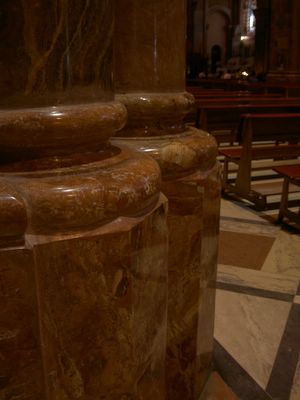

The exterior of the New Cathedral does not do justice to its interior grandeur. Its domes are an unmistakeable landmark, visible from almost any corner of the city, except right in front of it.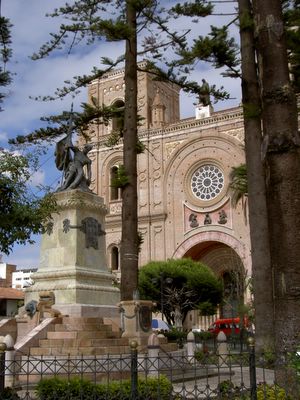
Also right in front of the New Cathedral was the unforgettable "Sweater Tree". When we arrived, a sweater in bright pink and red had been knitted around a prominent tree. I surmised that it was to keep the tree warm, but in fact it was purely decorative. The sweater is gone now, but not forgotten.
On the other side of the park is the Supreme Court of Azuay, an impressive and stately edifice that has been updated to meet the changing needs of the court building. Most of the office space has been converted to cubicles with the infrastructure for telephones, computers, and lights exposed. The interior is an eyesore compared with the magnificent stonework outside and in the entryway and courtyard as you enter.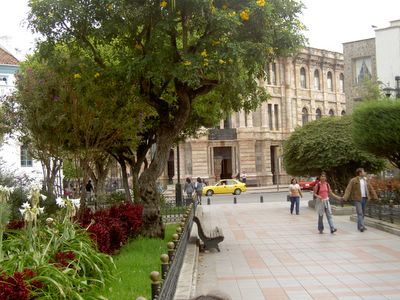

Many buildings in the Historic Center are dilapidated to the point of falling down. Some have been restored. Many architectural styles are present. Due to the extensive permitting process and funding required to renovate, many owners of architectural gems have opted to turn their first floors into parking spaces. This is indeed a sad state of affairs. The citizens here take great pride in their center, so I have confidence that this will turn around. One of the things I love about the center are the cobblestone streets and the gorgeous stones holding up buildings and holding down sidewalks.

We live across the river from the Historic Center. The bridge closest to our apartment is of the non-descript sort, but its stonework does add character.
On the other side of the bridge are the ruins of Tomebamba, the old city of the Incas. A statue of the Incan leader, Huayna Capac, who extended the Incan Empire to its most northern limits stands at its edge. His sons engaged in a horrific civil war, which opened the way for the relatively easy Spanish conquest. The Spanish then looted the existing stonework to construct many of the historic buildings of Cuenca.
Back on this side of the bridge, we have a garden view from our bedroom window. The garden separates us from the main house.
The walls of our apartment are painted in bright colors.
We live in the blacksmith's neighborhood. It is officially part of the Historic District, but not in the center. I was confused by this at first, until I read that people used to ride to town and leave their horses at the edge of town. It was a convenient time and place to have their horses re-shoed and so a blacksmith area grew up just outside of town. Horses rarely come to town now, but there are still ironworkers busy at their trade. There is a museum dedicated to the fire arts as well. In front of it is a statue of the mighty Vulcan.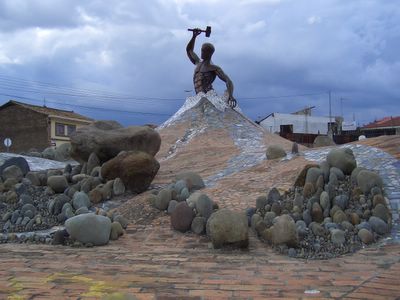


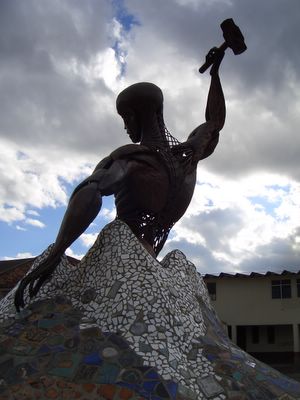

During one of the many city celebrations we witnessed, in front of the pillars dedicated to the many patrons of this museum, we saw some dramatic fire-breathing. It brought to mind the fires of the Burning Man Festival.
Down the road from this monument is a large city park, Parque Paraíso, that incorporates a bit of forest with a boardwalk, soccer fields in constant use, lots of shade, paddleboats, playground equipment, and many romantic spots for couples. There's one area with a down-sized replica of a city street complete with traffic signs. They use it to teach road-safety to children. We saw the symphony orchestra play here a couple of months ago.


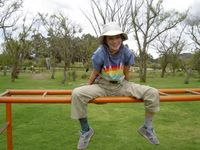 |  |
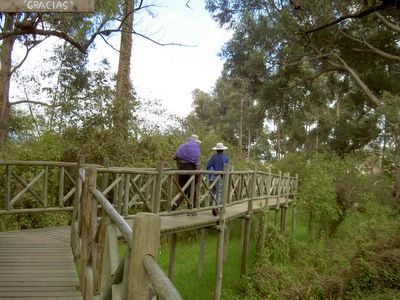
Calliope's favorite street scene was the lingerie shops, their glass storefronts brimming with merchandise.
A couple of weeks ago, the city installed a ceramic mosaic map of the Historic Center on strategic walls where tourists are likely to hang out.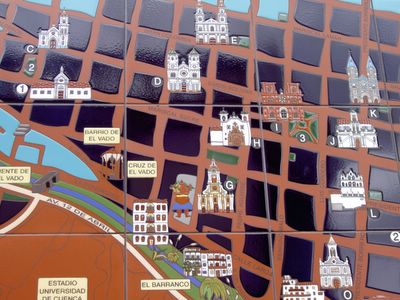
Farewell Cuenca - you have charmed us with your good looks, rich culture, kind residents, excellent Spanish teachers, and beautiful surroundings!
TM: I want to talk more about one of the least pleasant subjects of my life here in South America. Child labor. Next door to our house is a blacksmith's shop, and every morning when I walk by to go to school, I see the same kid(He cant be more than 15) working there. He is always covered in dirt of the black paint they use to cover the grills they make. I can't even look him in the eye. What could I say? What can I DO? It is always in the back of my mind. Nagging at me. How can I complain while this kid is working every day except Sundays without a single vacation, even during Christmas? I have it made. I really do. But I'm unhappy anway. Because, well, I guess I am used to better living and don't appreciate what I have. *Sigh*

No comments:
Post a Comment